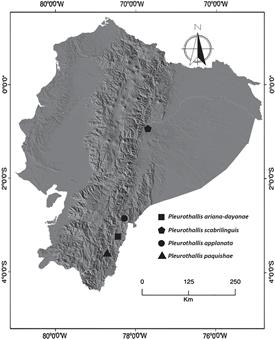Introduction
Pleurothallidinae Lindl. is one of the most species- rich neotropical orchid subtribes. Luer (1986) accounted for as many as 4000 species in the subtribe. About two decades later, Pridgeon (2005) accounted for 4100 species. Then, more than 30 years after Luer’s monograph, just over 5114 species are currently being accepted among the 12,000 published names applicable to the subtribe (Luer 1986, Karremans 2016, Karremans & Vieira-Uribe 2020). Pleurothallis R.Br., as defined by Pridgeon (2005), is a highly diverse neotropical orchid genus in the Pleurothallidinae, including some 500 species (Karremans & Vieira-Uribe 2020) ranging from Mexico, Central America, and the Caribbean to South America.
In his infrageneric classification of Pleurothallis,Lindley (1859) established Pleurothallis sect. Macrophyllae-Fasciculatae Lindl. for a group of plants characterized by fleshy, cordate leaves and fasciculate flowers. Later, Luer (1988) classified the group as a subsection of Pleurothallis creating Pleurothallis subsect. Macrophyllae-Fasciculatae.
This group was later given a generic status under Zosterophyllanthos Szlach. & Marg. (Szlachetko & Margonska 2001). However, Luer (2005) treated the members of Macrophyllae-Fasciculatae, together with Pleurothallis subsect. AcroniaeLuer (1986), under Acronia C.Presl. Nevertheless, according to available phylogenetic studies, this subsection is a monophyletic group, and the recognition of additional genera segregated from Pleurothallis is not yet supported (Karremans 2016, Pridgeon 2005, Wilson et al. 2011, 2013). Luer (2005) indicated that species of section Macrophyllae-Fasciculatae differ by the sessile leaves with a cordate base, the single or simultaneously flowers produced in a fascicle, with lateral sepals connate into a synsepal, the lip usually with a well-developed glenion, and a bilobed stigma.
In Ecuador, there are approximately 269 accepted species of Pleurothallis (WSCP, 2022), and the number of species recorded in the country increases quickly (Jiménez et al. 2018, 2021, Luer 2005, Luer & Thoerle 2012, 2013, Wilson et al. 2016, 2017, 2018, Zambrano et al. 2017). Around 56% (ca. 150 species of Ecuadorian Pleurothallis) are members of the subsection Macrophyllae-Fasciculatae (Zambrano et al. 2017). Recently, some specimens of Pleurothallis were collected from the Cordillera del Cóndor; when the material was compared with several species, it was found that they correspond to a different and unknown taxon described here.
Materials and methods
The description and illustration of the new taxon were generated from specimens collected during a comparative study on the orchids of the Cordillera del Cóndor under a permit granted by the Ministry of the Environment of Ecuador (No 037-2019-IC-FLO- FAU -DPAZCH-UPN-VS / MA). Photographs of individuals of the new species and morphologically similar species in bloom were taken using a Canon® EOS 1100D camera and +10 Kernel Pro Optics 58 mm close-up lenses and Panasonic® FZ300 camera with Raynox DCR-150 50 mm, EFS 18-58 mm lens. The systematics of Acronia by Luer (2005) and the new species were compared to the previously described related species (Lindley 1836, Luer 1979, 1996). The new species was compared in detail with P. paquishae Luer, to which it is morphologically most similar in appearance. Voucher specimens where deposited at Herbario Amazónico (ECUAMZ).
Taxonomic treatment
Pleurothallis ariana-dayanae Vélez-Abarca, M.M.Jiménez & D.Gutiérrez del Pozo, sp. nov. (Fig. 1, 2, 4A, 5A)
TYPE: Ecuador. Zamora Chinchipe: Cantón El Pangui, Cordillera del Cóndor flank, 1090 m, 15 Dec 2020, L. Vélez LV0067 (holotype: ECUAMZ!).
Diagnosis: Similar to Pleurothallis paquishae from which it differs by the lanceolate dorsal sepal (vs. narrowly elliptical), broadly ovate lateral sepals (vs. ovate), the petals with the apical third slightly falcate (vs. narrowly linear-oblong, recurved), minutely denticulate margins (vs. finely serrulate), the lip ovate-elliptical, papillose (vs. ovate-oblong, minutely spiculate), with a slightly bilobed glenion (vs. ovate).
Plant medium in size, up to 15 cm tall, epiphytic, caespitose; roots slender, flexuous, whitish, 1 mm in diameter. Ramicauls yellowish-green, erect, 6-12 cm long, with a tubular sheath on the lower third and two other sheaths at the base. Leaf horizontal, coriaceous, ovate, acute, 3.5-6.5 × 2.5-4.0 cm, the base sessile, deeply cordate, margin slightly involute. Inflorescence a fascicle of successive, single-flowered, resupinate, enclosed at the base by a spathaceous bract ca. 8 mm long; peduncle terete, 3 mm long, covered with the spathaceous bract; floral bract tubular, acute, 3 mm long; pedicel clavate, curved, ca. 4 mm long. Ovary smooth, lustrous, pedicellate, cylindrical, longitudinal sulcate, covered with black dots on the dorsal surface, with a slight curvature at the junction with the pedicel, 3 mm long, 0.7 mm in diameter. Flower small, the sepals brownish red, the petals reddish-brown, the lip brown to dark red-purple, the column light-green, the anther orange suffused with purple. Sepals fleshy; dorsal sepal lanceolate, subverrucose at the apical half, acute, 6.5-7.8 × 2.3- 2.4 mm, 3-veined; the lateral sepals connate into a broadly ovate, acute synsepal, concave at the base, subverrucose, lustrous on abaxial surface, 5.8-6.5 × 4.3-4.5 mm, 4-veined. Petals fleshy, slightly falcate, narrowly linear, acute, with a cleft in the basal third, microscopically verrucose-papillose on the dorsal surface, margins minutely denticulate, 4.0-4.5 × 0.75 mm, 1-veined. Lip fleshy, ovate-elliptic, obtuse, verrucose-papillose abaxially, margins minutely denticulate-ciliate, 3.2 × 2.0-2.2 mm, 3-veined, the disc with a small, slightly bilobed glenion near the base, the base subtruncate, shortly deflexed. Column short, stout, semiterete, 1.3 × 1.0 mm, with a short, thick, obsolescent foot; stigma apical, bilobed. Anther cap apical, sub-globose-cordiform, minutely papillose, 0.5-0.6 × 0.5-0.6 mm. Pollinia 2, obovoid. Capsule not seen.
Eponymy: Combination of the names of the first author’s daughters Nathasha Ariana and Dayana Mishell.
Distribution and habitat: The new species is an epiphyte growing under the shade of Chrysophyllum sanguinolentum (Pierre) Baehni (Sapotaceae), and Protium amazonicum (Cuatrec.) Daly (Burseraceae), trees in dwarf forests of a sandstone plateau of the Cordillera del Cóndor located in the Amazonian region of south-eastern Ecuador. This territory is characterized by dense vegetation, including trees with abundant bryophytes and lichens. The Cordillera del Cóndor plateau zone is the southern portion of the ''Andean Tepui Region'' proposed by Neill (2007) and Neill et al. (2014), areas of very high diversity whose biological richness is only partially described to date.
Pleurothallis ariana-dayanae generally grows in shady areas, on branches parallel to the ground, in the middle layer of small trees with very small diameters, typical of the vegetation of the Cordillera del Cóndor. It has been found at 980 to 1100 m above sea level.
Pleurothallis ariana-dayanae (Fig. 2, 4A, 5A, 6A) is very similar to other species of the ''scabrilinguis'' morphological group (Fig. 4), characterized by its elliptic-lanceolate dorsal sepal, narrowly linear, slightly falcate petals, an ovate- elliptic lip with a slightly bilobed glenion, and a sub-globose-cordiform anther. Among them, the most similar species is P. paquishae (Fig. 3, 4B, 5B, 6C), which has the same distribution in Ecuador in the Cordillera del Cóndor. These two species are vegetatively similar, but they differ strongly in the floral parts; the flower of P. ariana-dayanae is proportionally smaller (Fig. 4A-B), the dorsal sepal is lanceolate, 6.5-7.0 × 2.3-2.4 mm (vs. narrowly elliptical 11.0 × 3.5 mm), the synsepal measures 5.8-6.0 × 4.3-4.5 (vs. 11 × 6 mm), the petals have the apical third slightly falcate, 4.0-4.5 × 0.75 mm (vs. apical third slightly recurved, 9.5 × 1.0 mm), the lip may have a brown to dark purple-red color, ovate- elliptical, 3.0 × 2.0-2.2 mm, the surface papillose, minutely denticulate-ciliate margins, with a slightly bilobed glenion (vs. lip red to velvety brown, ovate- oblong, 5.5 × 2.5 mm, surface thoroughly verrucose- spiculated, denticulate margin, turned-shaped glenion) anther cap sub-globose (vs. cordiform with horn-shaped upper lobes ) (Fig. 5A-B).
This species could also be mistaken as a variation of P. applanata (Fig. 4C, 5C, 6B) since they are superficially similar; however, the color of the flowers in P. applanata is variable from a purple- brown color (hue shared with P. ariana-dayanae), yellow hue, tan hue and intermediate colors between yellow and purple-brown. This color variation is something that does not occur in the new species. In addition, P. ariana-dayanae is a species with a smaller flower (Fig. 4), dorsal sepal lanceolate, sub- verrucose at the apical half, 6.5-7.0 × 2.3-2.4 mm (vs. narrowly elliptical-ovate, glabrous, 10.0 × 3.6 mm), lateral sepals broadly ovate, subverrucose, 5.8- 6.0 × 4.3-4.5 mm (vs. ovate, smooth, 9.5 × 6 mm). Lip ovate-elliptical, 3.0 × 2.0-2.2 mm, with a slightly bilobed glenion (vs. oblong-ovate, 4.5 × 2.2 mm, with an orbicular glenion), anther cap sub-globose (vs. cordiform) (Fig. 6).
Another similar species is Pleurothallis scabrilinguis (Fig. 4D, 5D), but they differ from P. ariana-dayanae by leaf ovate, deeply cordate, 3.5-6.5 × 2.5-4.0 cm (vs. narrowly ovate, base shallowly cordate, 4-10 × 1-2 cm), floral bract 3 mm long (vs. 4-7 mm long), pedicel 4 mm long (vs. 5-10 mm long), dorsal sepal lanceolate, sub-verrucose at the apical half, acute, 6.5-7.8 × 2.3-2.4 mm (vs. elliptical-ovate, glabrous, subacute to obtuse, 6-10 × 2.5-7.0 mm), lateral sepals subverrucose, acute synsepal, 5.8-6.0 × 4.3-4.5 mm (vs. glabrous, obtuse, 5-10 × 4-8 mm ), petals slightly falcate, with a cleft in the basal third, microscopically verrucose-papillose on the dorsal surface, 4.0-4.5 × 0.75 mm (vs. glabrous on the dorsal surface, 3-7 × 0.5-1.2 mm), lip ovate-elliptic, obtuse, verrucose-papillose abaxially, margins minutely denticulate-ciliate, with a slightly bilobed glenion, 3.2 × 2.0-2.2 mm (vs. triangular, oblong, subacute or round at the apex, papillose abaxially with denticulate margins, turned-shaped glenion, 3-7 × 2-4 mm), anther cap, sub-globose, (vs. cordiform) (Fig. 6D).
Conservation status: This species has been only reported from the cantón of El Pangui (Fig. 7) in the province of Zamora Chinchipe, Ecuador. The plateau where P. ariana-dayanae was found could act as a natural barrier that determines its restricted distribution; perhaps more research in other similar ''tepuis'' from Ecuador and Peru will lead to discovering new populations of P. ariana-dayanae. However, only three populations were found in an area no greater than 49 km2. Microendemism is restricted to an area subject to rapid deforestation due to mining activities.
Other specimens examined: Ecuador. Zamora Chinchipe: Cantón El Pangui, Cordillera del Cóndor, near Tundayme, 1170 m, 12 Mar 2022, L. Vélez LV0071 (ECUAMZ!); near El Quimi, 14 Mar 2022, L. Vélez LV0070 (ECUAMZ!).
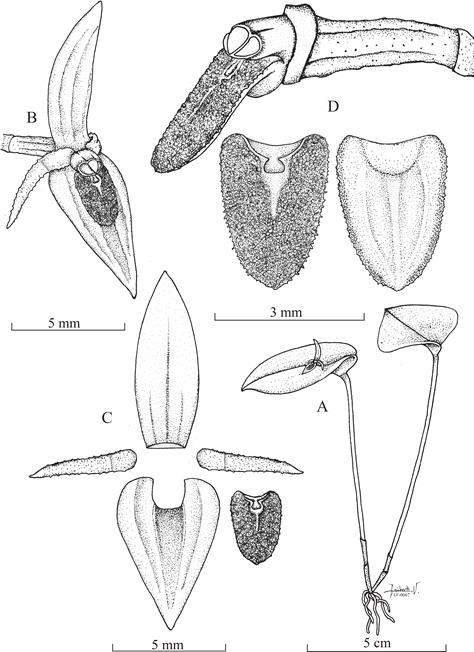
A. Habit.
B. Flower, – view.
C. Dissected perianth.
D. Ovary, column and lip in lateral view, and lip adaxial and abaxial view.
Illustration by L. Vélez-Abarca, based on the holotype Vélez-Abarca LV-0067 (ECUAMZ).
Figure 1 Pleurothallis ariana-dayanae Vélez-Abarca, M.M.Jiménez & D.Gutiérrez del Pozo.
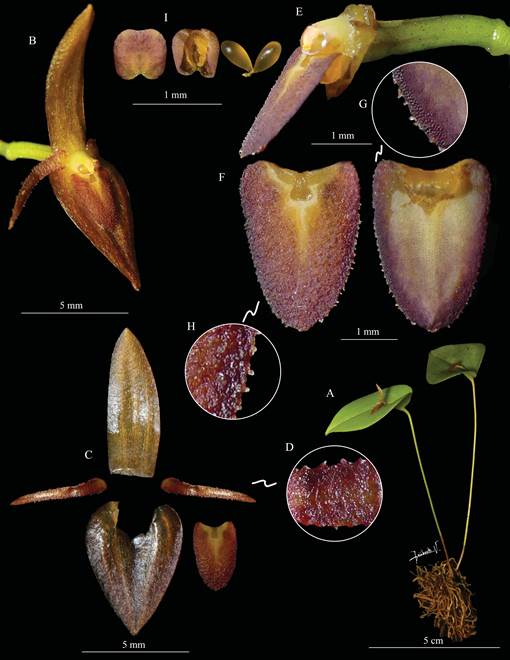
A. Habit.
B. Flower, – view.
C. Perianth dissected.
D. Close-up of the petal margin.
E. Ovary, column, and lip, lateral view.
F. Lip, adaxial and abaxial view.
G. Close-up to the abaxial margin of the lip.
H. Close-up to the adaxial margin of the lip.
I. Anther cap and pollinia. LCDP by L. Vélez-Abarca
from photos by M. M. Jiménez based on the holotype Vélez-Abarca LV-0067 (ECUAMZ).
Figure 2 Pleurothallis ariana-dayanae Vélez-Abarca, M.M.Jiménez & D.Gutiérrez del Pozo.
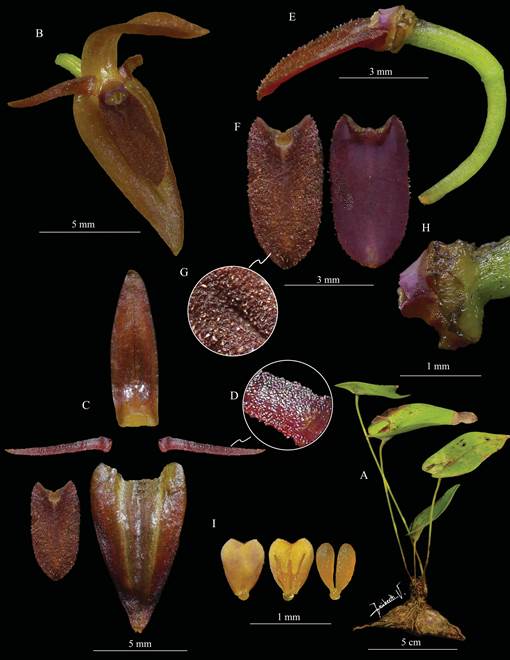
A. Habit.
B. Flower, – view.
C. Perianth dissected.
D. Close-up of petal margins.
E. Pedicel, ovary, column, and lip, lateral view.
F. Lip, adaxial and abaxial views.
G. Close-up to the adaxial surface of the lip.
H. Close-up of column, lateral view.
I. Anther cap and pollinia.
LCDP by L. Vélez-Abarca
from photos by M. M. Jiménez based on Jiménez M. 1313 (ECUAMZ).
Figure 3 Pleurothallis paquishae Luer.
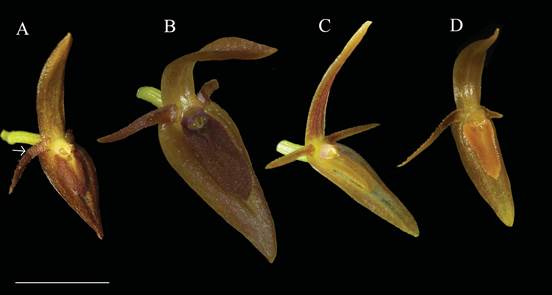
A. Pleurothallis ariana-dayanae.
B. Pleurothallis paquisahe.
C. Pleurothallis applanate, based on Jiménez M. 796 (ECUAMZ).
D. Pleurothallis scabrilinguis, based on Jiménez M. 1134 (ECUAMZ). Scale bar = 5 mm.
By L. Vélez-Abarca from photos by M. M. Jiménez.
Figure 4 Comparison of the flowers between related species.

A. Pleurothallis ariana-dayanae.
B. Pleurothallis paquishae.
C. Pleurothallis applanata.
D. Pleurothallis scabrilinguis.
Scale bar = 3 mm.
Figure by L. Vélez-Abarca from photos by M. M. Jiménez.
Figure 5 Comparison of the lip in adaxial and abaxial views, and the glenion.

A. Pleurothallis ariana-dayanae.
B. Pleurothallis applanata.
C. Pleurothallis paquishae.
D. Pleurothallis scabrilinguis.
Scale bar = 0.5 mm.
Figure by L. Vélez-Abarca from photos by M. M. Jiménez.
Figure 6 Frontal view of the column, anther and pollinarium.












 uBio
uBio 

